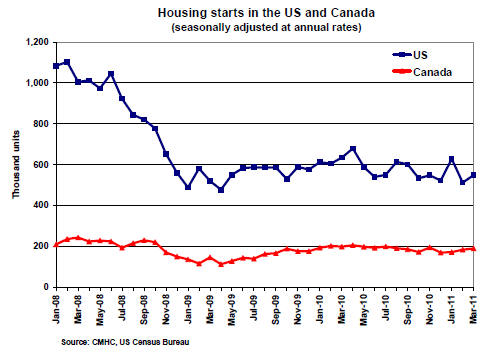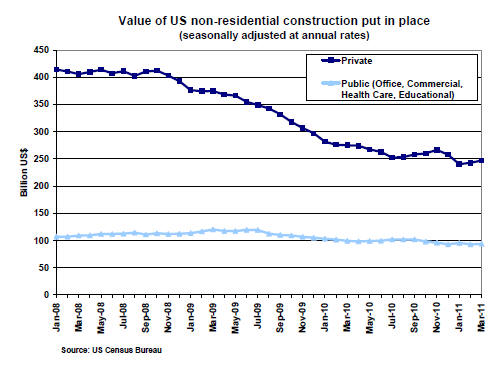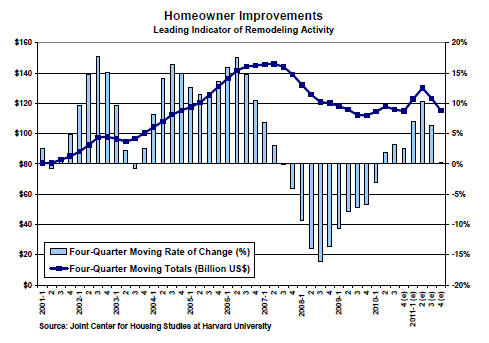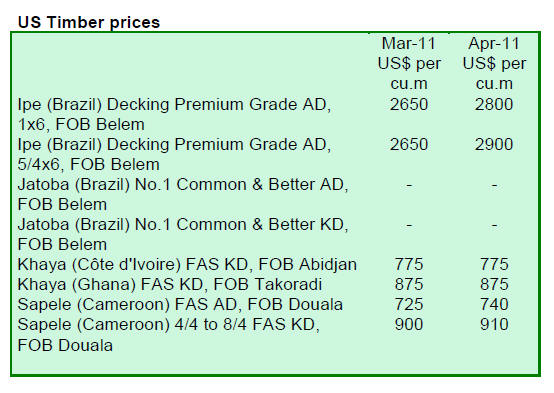|
Report
from
North America
Depressed housing market holds back US economic recovery
GDP growth in the US slowed to 1.8% in the first quarter
of 2011, down from 3.1% in the last quarter of 2004
according to the US Department of Commerce. Consumer
spending accounts for about 70% of the US economy, and
high gasoline prices are largely blamed for the slow
economic growth.
Other factors were the unusually harsh weather in late
winter, which kept people from shopping and delayed
construction projects. The federal government also cut
military spending. However, the main factor holding back
the economic recovery is the weak housing market
according to the Federal Reserve.
Wood product manufacturing saw the highest growth of
all industries in April, while manufacturing of furniture
and related products declined. The Institute for Supply
Management reports the manufacturing sector expanded in
April for the 21st consecutive month. Manufacturing has
been the strongest economic sector since the recession
ended. Export demand was helped by a weak US dollar,
but rising material costs put pressure on profits.
Productivity increased again in the first quarter of 2011,
but the productivity growth was lower than in the previous
quarter (1.6% compared to 2.9% in Q4 2010). The US
Department of Labor expects production growth to slow
because companies are reaching the limits of producing
more goods and services with fewer workers. In the short
term a decline in productivity growth will be positive
because companies will hire more workers.
Unemployment increased to 9% in April from 8.8% in
March because many people resumed their job search
according to the US Department of Labor. At the same
time employers created additional 244,000 jobs, the
highest increase in five years. The private sector added
jobs while all levels of government cut jobs in April.
However, the number of unemployed people is still almost
double than before the recession started. It could take four
to five years before the unemployment rate drops to the
usual rate of around 6%.
Slow start to spring home buying in the US
The high number of foreclosed homes on the market, low
home prices and tight credit continue to keep new home
construction at relatively low levels. Builders are only
slowly building up their inventory of new homes,
expecting a gradual improvement in demand according to
the National Association of Home Builders.
Construction of new homes went up in March after
disappointing figures earlier this year. Housing starts
increased by 7.2% from February to 549,000 (seasonally
adjusted annual rate) according to US Department of
Commerce figures. This is still 13.4% below the starts in
March last year. Single-family starts went up by 7.7%
from February to 392,000. The US South was the only
region where housing starts declined in March.
Permits for new homes improved more than starts and
were estimated at 405,000 in March, up by 11.2%
compared to February. The number of permits issued can
be an indicator of future building activity. Sales of new
single-family homes increased by 11.1% in March,
partially offsetting the large drop in February according to
US Department of Commerce figures.
The northeastern region posted again the highest increase
in sales (up 67%), followed by the West and Midwest.
New home sales were almost unchanged in the South. The
inventory of new homes on the market remains very low.
The National Association of Home Builders reports that
the builders’ confidence in the market for new singlefamily
homes dropped in April 2011. The drop was largely
due to low home sale expectations in the US South. Sales
of lower-priced homes have been doing well as have
purchases by first-time home buyers who do not have a
current home to sell and can take advantage of low
property prices and low mortgage rates.
Canadian housing market fully recovered
Canadian housing starts increased to 185,100 in March
(seasonally adjusted annual rate), up 2.6% from February.
The increase was mainly due to higher rural housing starts,
while in urban areas construction of single-family homes
declined while multi-family starts increased.
House construction is expected to decline in the second
half of 2011 according to Conference Board of Canada
forecasts. The government’s Canada Housing and
Mortgage Corporation expects the sustainable level of new
home construction to be below the high levels seen in
2002 to 2008, when annual housing starts were above
200,000. The agency forecasts a total of 177,600 housing
starts for 2011, which is slightly less than in 2010.
First quarter investment in non-residential building
construction increased by 1.3% from the previous quarter.
The growth was concentrated in Ontario and Quebec.
Canada’s central bank has left its key interest rate
unchanged at 1.0% since last September. The
unemployment rate declined further in April to 7.6%.

Only slight improvement in US non-residential construction
Construction of non-residential buildings improved
slightly in March, but the American Institute of Architects
reports only a marginal improvement in business
conditions. Credit for non-residential projects remains
tight. The commercial/industrial sector has seen more
building activity than institutional building construction.

No significant growth in home renovation spending expected
The outlook for home remodeling expenditures in 2011
was revised downward by the Joint Center for Housing
Studies of Harvard University. The state of the housing
market and concerns over the slow economic recovery is
expected to moderate growth in spending on remodeling.
Spending levels in the second and third quarter of 2011
(spring and summer) are likely to surpass 2009 and 2010
spending levels, but by the end of 2011 expenditures are
expected to be back to the relatively low levels of 2010.
The National Association of Home Builders Remodeling
Market Index reached its highest level in four years in the
first quarter of 2011. Despite the improvement the
companies surveyed indicated low levels of home
remodeling activities.

FSC-certified wood fastest growing green building
material to 2015
Sawnwood and woodbased panels certified by the Forest
Stewardship Council (FSC) are expected to see the
strongest growth of all green building materials. A report
by Freedonia (Green Building Materials Market) forecasts
a 13% growth in US demand for green building materials.
Floor coverings accounted for almost one quarter of green
building material demand in 2010 and included bamboo
and cork flooring because they are made from rapidly
renewable resources. The green building certification
system LEED is the main driver of FSC-certified wood in
green building in the US and Canada, but several other
certification systems and assessment tools are also used.

Related News:
|